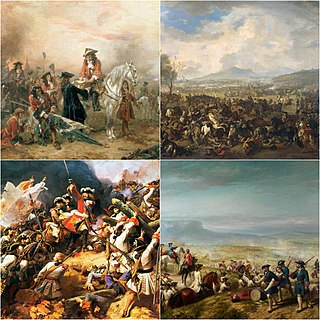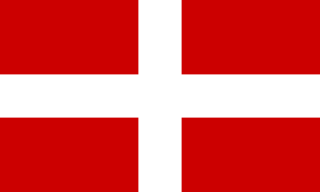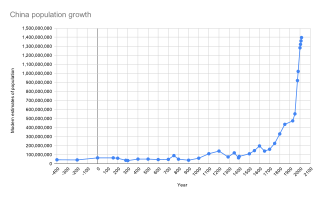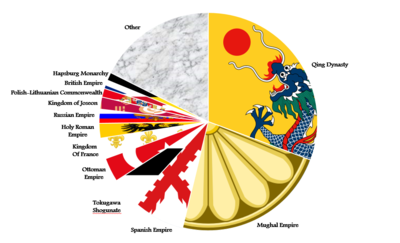
India is the most populous country in the world with one-sixth of the world's population. According to estimates from the United Nations (UN), India has overtaken China as the country with the largest population in the world, with a population of 1,425,775,850 at the end of April 2023.

The War of the Spanish Succession was a European great power conflict fought between 1701 and 1714. The immediate cause was the death of the childless Charles II of Spain in November 1700, which led to a struggle for control of the Spanish Empire amongst supporters of the claimant Bourbon and Habsburg dynasties. His official heir was Philip of Anjou, a grandson of Louis XIV of France, whose main backers were France and most of Spain. His rival, Archduke Charles of Austria, was supported by the Grand Alliance, whose primary members included Austria, the Dutch Republic, and Great Britain. Significant related conflicts include the 1700 to 1721 Great Northern War, and Queen Anne's War in North America.

The Great Northern War (1700–1721) was a conflict in which a coalition led by the Tsardom of Russia successfully contested the supremacy of the Swedish Empire in Northern, Central and Eastern Europe. The initial leaders of the anti-Swedish alliance were Peter I of Russia, Frederick IV of Denmark–Norway and Augustus II the Strong of Saxony–Poland–Lithuania. Frederick IV and Augustus II were defeated by Sweden, under Charles XII, and forced out of the alliance in 1700 and 1706 respectively, but rejoined it in 1709 after the defeat of Charles XII at the Battle of Poltava. George I of Great Britain and the Electorate of Hanover joined the coalition in 1714 for Hanover and in 1717 for Britain, and Frederick William I of Brandenburg-Prussia joined it in 1715.

Prussia was a German state located on most of the North European Plain, also occupying southern and eastern regions. It formed the German Empire when it united the German states in 1871. It was de facto dissolved by an emergency decree transferring powers of the Prussian government to German Chancellor Franz von Papen in 1932 and de jure by an Allied decree in 1947. For centuries, the House of Hohenzollern ruled Prussia, expanding its size with the Prussian Army. Prussia, with its capital at Königsberg and then, when it became the Kingdom of Prussia in 1701, Berlin, decisively shaped the history of Germany.

A rump state is the remnant of a once much larger state, left with a greatly reduced territory in the wake of secession, annexation, occupation, decolonization, or a successful coup d'état or revolution on part of its former territory. In the last case, a government stops short of going into exile because it controls part of its former territory.

This article lists current estimates of the world population in history. In summary, estimates for the progression of world population since the Late Middle Ages are in the following ranges:

Demographic history is the reconstructed record of human population in the past. Given the lack of population records prior to the 1950s, there are many gaps in our record of demographic history. Historical demographers must make do with estimates, models and extrapolations. For the demographic methodology, see historical demography.

From the 1680s to 1789, Germany comprised many small territories which were parts of the Holy Roman Empire of the German Nation. Prussia finally emerged as dominant. Meanwhile, the states developed a classical culture that found its greatest expression in the Enlightenment, with world class leaders such as philosophers Leibniz and Kant, writers such as Goethe and Schiller, and musicians Bach and Beethoven.

Demographic features of the population of Japan before the Meiji Restoration include aspects of nationality, religion, and ethnicity.

The Transformation of the Ottoman Empire, also known as the Era of Transformation, constitutes a period in the history of the Ottoman Empire from c. 1550 to c. 1700, spanning roughly from the end of the reign of Suleiman the Magnificent to the Treaty of Karlowitz at the conclusion of the War of the Holy League. This period was characterized by numerous dramatic political, social, and economic changes, which resulted in the empire shifting from an expansionist, patrimonial state into a bureaucratic empire based on an ideology of upholding justice and acting as the protector of Sunni Islam. These changes were in large part prompted by a series of political and economic crises in the late 16th and early 17th centuries, resulting from inflation, warfare, and political factionalism. Yet despite these crises the empire remained strong both politically and economically, and continued to adapt to the challenges of a changing world. The 17th century was once characterized as a period of decline for the Ottomans, but since the 1980s historians of the Ottoman Empire have increasingly rejected that characterization, identifying it instead as a period of crisis, adaptation, and transformation.

The Savoyard state is a term of art used by historians to denote collectively all of the states ruled by the counts and dukes of Savoy from the Middle Ages to the formation of the Kingdom of Italy. This state was an example of composite monarchy. At the end of the 17th century, its population was about 1.4 million.

The population history of China covers the long-term pattern of population growth in China and its impact on the history of China. China's population grew significantly over the centuries, putting pressure on the available arable land. This led to remarkable changes in agriculture, such as the introduction of new crops and farming techniques, to increase productivity.














